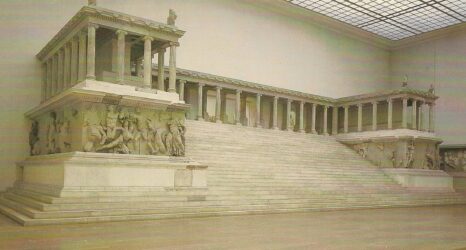
#Altar of #Zeus ? at #Pergamon, #Turkey: the #Throne-of-Satan
And to the angel of the congregation that is in Pergamon write: “Thus says the one who has the sharp, two-edged sword:
‘I know where you dwell, where the throne of #Satan is, and you hold fast to my name and you did not deny my faith even in the days of Antipas, my witness, my faithful one, who was killed among you, where Satan dwells.’”
(Revelation 2:12–13)
On a symbolic level, the “throne of Satan” mentioned in this passage represents a power in opposition to #God, a power that is embodied in Roman imperial might. Throughout Revelation, a system of symbols associates Satan, depicted as a #dragon or #serpent, with the #Roman #Empire and emperor depicted as a #beast.
Unlike other early Christian writers, #John the #prophet did not encourage his audience to honor and obey the emperor, but instead encouraged—by means of his symbols and rhetoric—resistance.
In principle, during the first century C.E., Roman officials tolerated believers in #Jesus as the Messiah insofar as they could be regarded as Jews. Jews were expected to honor the emperor and to pray for his welfare, as well as for the welfare of the empire. As monotheists, however, they were normally not expected to worship the emperor, as most Greeks and Hellenized provincials did with enthusiasm. Nero’s police action against the Christians of Rome in 64 C.E., however, apparently set a precedent for executing Christians merely for being such, and by the time of Trajan (emperor from 98–117 C.E.). Christians who refused to curse Jesus Christ and to worship the emperor, along with the traditional gods, were liable to execution as stubborn adherents of “superstition.” #Nero’s action marks the beginning of the end of Roman acceptance of Christianity as a Jewish movement.
John’s imagery in #Revelation is more than symbolic, however. The very explicit association the author makes between the “throne of Satan” and the city of Pergamon suggests that something visible in the city inspired the phrase. Taken together, the #archaeological and textual #evidence points to the same candidate: the Great Altar of Pergamon, one of the most significant (and stunning) monuments to survive from the Greco-Roman world. To John of Revelation, it is the “throne of Satan.”
Pergamon (modern #Bergama, in Turkey) is located on the Caicus River in western #Asia-Minor in the region traditionally called Mysia. In John’s time, Mysia was part of the Roman province of Asia.
The oldest part of the city is the acropolis, which is considerably higher and steeper than the acropolis of Athens. The earliest record of settlement comes from Xenophon, a Greek who lived in the fourth century B.C.E. He writes about Pergamon’s role in the Spartan campaigns of 399 B.C.E.1 In the third century B.C.E. Pergamon was the center of the Hellenistic kingdom of the Attalids. When the last Attalid king died in 133 B.C.E., he willed his kingdom to Rome, and the Romans transformed the old Attalid kingdom into their province of Asia. Pergamon was one of the three most prominent cities of that province (along with Ephesus and Smyrna). Pergamon continued to be a leading city until the fourth century C.E.
The ruins of the ancient city visible today include a temple dedicated to the emperor Trajan and a theater on the top of the acropolis. The base of the Great Altar lies prominently on a terrace on the southern slope of the acropolis. A lower city circled the base of the acropolis. A road led from there to a compound dedicated to the god Asklepios. This compound served as a medical center, a spa and a center for rhetoric and the arts, as well as a shrine to the deity.
The Pergamon altar itself is now housed in the Pergamon Museum in Berlin. In the second half of the 19th century, stones from the ancient citadel on the acropolis of Pergamon were being burned in order to procure lime, so excavations sponsored by the Berlin Museum were carried out between 1878 and 1886. The Great Altar and many of its sculptures were removed with permission of the authorities in Turkey and taken to the museum in Berlin.
The purpose of Pergamon’s Great Altar is uncertain and continues to provoke debate. Was it a real altar on which meat from sacrificed animals would be burned or was it a victory monument with no sacrificial function?2
As for its date, however, a consensus has emerged that the Great Altar was constructed during the reign of the Attalid king Eumenes II, who was born in 221 B.C.E. and reigned from 197 to 159 B.C.E.3 It is likely that the altar was intended as a monument celebrating the victories of Eumenes II’s predecessors, as well as his own, including the Roman victory over the Seleucid king Antiochus III, with the assistance of Eumenes II, in 189 B.C.E. The altar was never completed,4 but it was unquestionably one of the city’s most important landmarks in antiquity.
https://library.biblicalarchaeology.org/article/satans-throne/